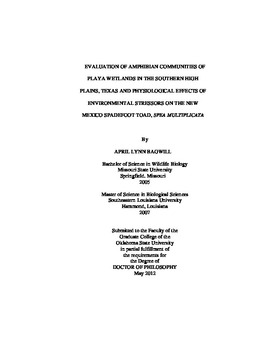| dc.contributor.advisor | McMurry, Scott T. | |
| dc.contributor.author | Bagwill, April Lynn | |
| dc.date.accessioned | 2013-11-26T08:28:19Z | |
| dc.date.available | 2013-11-26T08:28:19Z | |
| dc.date.issued | 2012-07 | |
| dc.identifier.uri | https://hdl.handle.net/11244/7025 | |
| dc.description.abstract | Scope and Methods: The purpose of this dissertation project was two-fold, 1) to investigate the effects of surrounding land use on playa wetlands and resident amphibian communities and 2) to assess developmental and physiological effects of water loss and agricultural pesticide exposure on the New Mexico spadefoot toad, Spea multiplicata . In 2008 and 2009 I collected data on hydroperiod, water loss, sediment depth, and amphibian diversity in playa wetlands that were surrounded by cropland, native grassland, or USDA Conservation Reserve Program (CRP) grasses. | |
| dc.description.abstract | Findings and Conclusions: Overall, playas located within CRP watersheds had sediment depths, water loss rates, and starting water depths intermediate to cropland and grassland playas. However, hydroperiod, playa area, and amphibian richness did not differ among land uses. Although species richness did not differ among land use types, distribution of amphibian species among land use types did differ, particularly in the drier 2008 season. This study is the first to definitively investigate CRP effects on playa amphibian communities. Because of environmental stressors observed in the field, I conducted three laboratory experiments investigating effect of water loss and water loss and a pesticide, atrazine, on development, spleen size and cellularity, and corticosterone levels of the New Mexico spadefoot toad, Spea multiplicata . Water loss accelerated development in the first two experiments, but did not affect body size or spleen cellularity. Corticosterone was negatively correlated with body size and elevated in tadpoles subjected to declining water levels. In the third experiment, I subjected tadpoles to water loss coupled with four concentrations of atrazine. Overall, there was no interaction between water regime and atrazine exposure. There were significant stage by water regime treatment interactions for snout-vent length, body weight index, and spleen weight. At metamorphosis, constant individuals were 8% larger in snout vent length, had 18% greater body weight indices, and 20% larger spleens. Corticosterone (CORT) level doubled at the highest atrazine concentration (50 microg/L), and was negatively correlated with snout-vent length, body weight index, spleen weight, and total spleen leukocytes at metamorphosis. Atrazine also influenced metamorphic rate and increased the average number of days to metamorphosis. This study suggests that environmental stressors seen in the field can affect development and immune function of amphibians, but effects do not manifest until metamorphosis when animals are already susceptible. | |
| dc.format | application/pdf | |
| dc.language | en_US | |
| dc.rights | Copyright is held by the author who has granted the Oklahoma State University Library the non-exclusive right to share this material in its institutional repository. Contact Digital Library Services at lib-dls@okstate.edu or 405-744-9161 for the permission policy on the use, reproduction or distribution of this material. | |
| dc.title | Evaluation of amphibian communities of playa wetlands in the Southern High Plains, Texas and physiological effects of environmental stressors on the New Mexico spadefoot toad, Spea multiplicata | |
| dc.contributor.committeeMember | Belden, Jason B. | |
| dc.contributor.committeeMember | Blouin, Edmour Francis | |
| dc.contributor.committeeMember | Lovern, Matthew B. | |
| dc.contributor.committeeMember | Smith, Loren Michael | |
| osu.filename | Department of Zoology_01.pdf | |
| osu.accesstype | Open Access | |
| dc.type.genre | Dissertation | |
| dc.type.material | Text | |
| dc.subject.keywords | amphibian | |
| dc.subject.keywords | atrazine | |
| dc.subject.keywords | environmental stress | |
| dc.subject.keywords | playa wetland | |
| dc.subject.keywords | water loss | |
| thesis.degree.discipline | Zoology | |
| thesis.degree.grantor | Oklahoma State University | |
